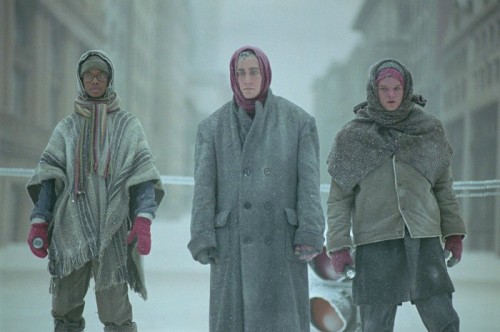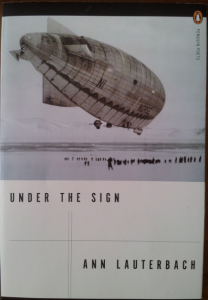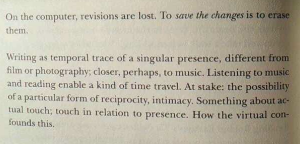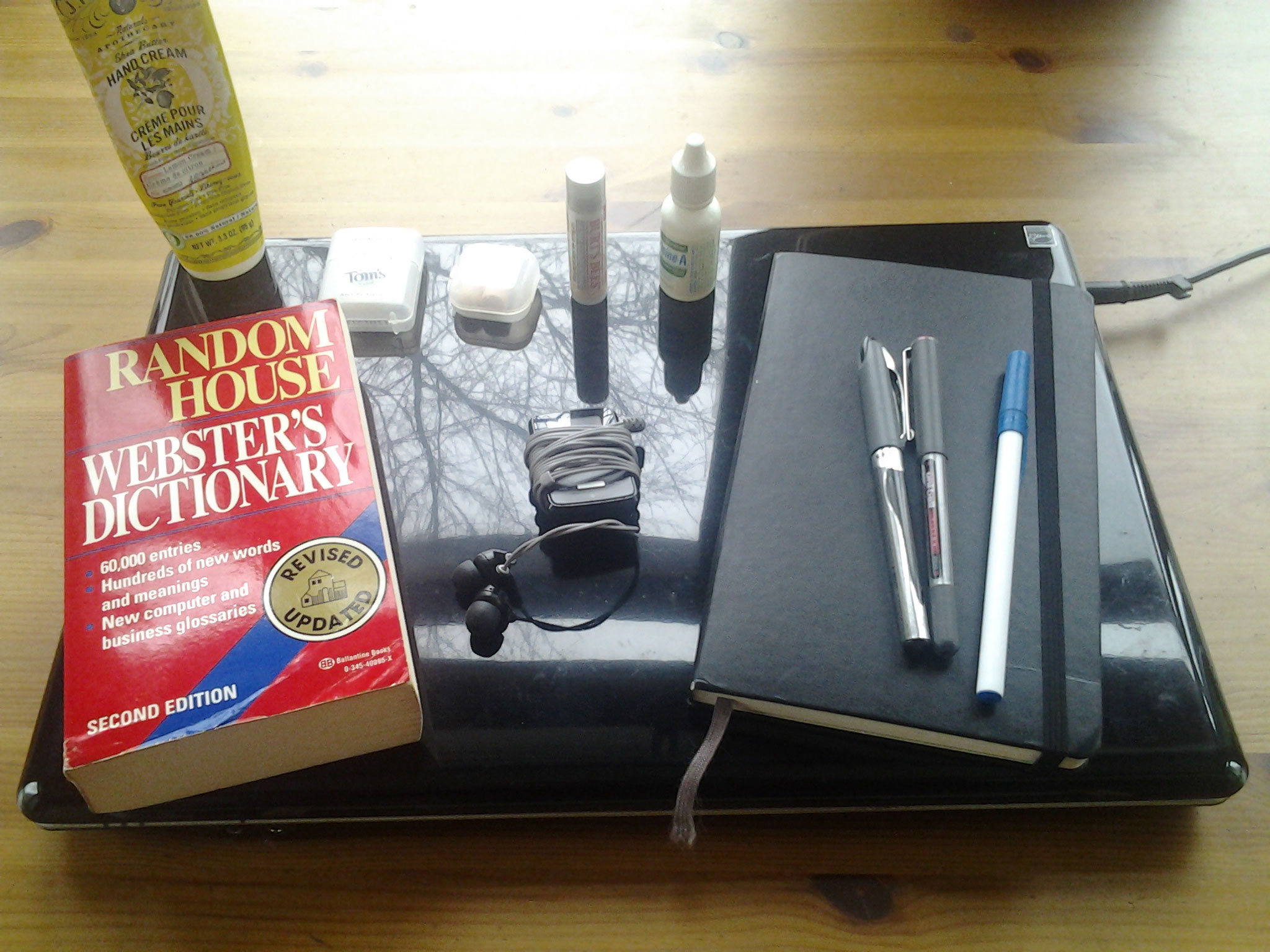The Life of the Goats So Far
If there’s a musician out there today writing more literary lyrics than John Darnielle, the great dark Chekhovian pen, voice and guitar at the center of The Mountain Goats, I haven’t heard her or him. (And don’t come near me with that Decembrists shit.) To help mark the occasion of the release of a new Mountain Goats album (their 17th studio effort), The Life of the World to Come, I asked extreme Goats enthusiast Alec Niedenthal to write a piece about the band’s body of work. Click through and find yourself in the life of the world of Alec’s capable, busy hands.
November 10th, 2009 / 1:42 pm
NYC Area Alert: What’s better than AIDS? Fun Literary Events!
The venerable and perpetually awesome Housing Works Bookstore–a nonprofit that helps homeless people with AIDS in NYC–is throwing two events in the near future that you should know about. The first one is Thursday (as in The Day After Tomorrow) and it is a Literature Quiz Show, emceed by father-daughter team Kenneth and Jenny Davis, authors of Don’t Know Much About Literature: What You Need to Know but Never Learned About Great Books and Authors. All comers are welcome to get in on the action, and you’ll be playing against literary notables such as Garth Risk Hallberg, Jason Boog, Ed Champion, and HTMLGiant’s own Catherine Lacey. I wish wish wish I could be there quizzing it out with ya’ll, but I’ll be stuck doing the next best thing–hanging out in New Jersey generating fodder for more Creative Writing 101 posts. Full event details here.
And hey, now that you know how to get to Housing Works, why don’t you come back the next night (Friday) for something called the “Read-N-Rock-N-Roll YA Variety Show” which will feature Frank Portman, the author of King Dork (and, apparently, the dude from Mr. T Experience–who knew?) reading “and singing” from his new novel Andromeda Klein. There’s a lot more going on at this, but if I let this post get any longer Father Blake is going to slap me with a “read more after the jump,” so just click here if you want to learn more about the special guests at the Portman thing.
September 16th, 2009 / 11:59 am
250 Points: The Hobbit pt 2: The Desolation of the Hobbit
- I missed The Hobbit: The Desolation of Smaug in theaters. Obviously since I wrote so much about the last one, I considered seeing its follow-up on more than one occasion, but just couldn’t summon the energy, even though a good friend invited me to join her, promising she’d bring snacks from Trader Joe’s.
- And then a few days after that, while I was out strolling the boulevard, I passed another friend who was en route to see the thing, on a lazy, chilly Sunday afternoon. But instead of joining him, I went home and took a bath.
- So you can see how excited I was to watch this movie. Please keep that in mind as you read this.
- Then the film left theaters, and I realized I’d missed my one and only chance for all time. I rushed to my local multiplex and pleaded with its employees to give me a private screening, but they refused, and threatened to call the police. Again.
- I despaired, and spent a week wondering what had happened to Bilbo, and Gandalf, and Thorin, and Whorin, and Hewy, and Dewy, and Chewy, and Killy, and Thrilly, and Culty, and the ninety-seven other little dwarves, and everyone else in Middle-earth.
- Suddenly, just when I could no longer bear the suspense, a CGI moth flew through my window, gripping an AVI copy of the film in its fuzzy mandible. It landed on my shoulder and mumbled something about how Gandalf was in trouble and “needed me.”
- Well, I need you, too, Gandalf! So I decided to watch the movie, after all, and take a lot of notes.
- These are my notes.
- It’s been fifteen long months since I watched An Unexpected Journey, and I barely remember anything that happened in it.
- It occupied a tremendous number of minutes? And presented a great many wolves and goblins that were born in a super-computer’s digital bowels?
- I do recall that the movie featured at least one terrific scene: the riddle game between Bilbo and the creature known as Gollum.
- Gollum won’t be in this new film, I have heard, which is a minus going in.
- Even still, I have no doubt that this movie will do its best to amuse and delight us, because that is how capitalism works. So let’s get right to it! READ MORE >
Interview With Luis Panini
 Luis Panini is one of the most talented writers you’ve never heard of. With writing that recalls the best of Franz Kafka, Lydia Davis, David Foster Wallace, and Julio Cortázar, it is a regret that his writing can not be read in English (until now! see below). I recently sat in on a class at CalArts where he was a special guest in my friend Laura Vena’s class on Latin American literature, and it was a huge pleasure to hear him talk about his writing and thought processes. Laura Vena translated a few of his short stories (or fragments) into English, the results of which can be found below, and so I’m hugely happy and excited to share this interview here and debut these new translations of his work into English.
Luis Panini is one of the most talented writers you’ve never heard of. With writing that recalls the best of Franz Kafka, Lydia Davis, David Foster Wallace, and Julio Cortázar, it is a regret that his writing can not be read in English (until now! see below). I recently sat in on a class at CalArts where he was a special guest in my friend Laura Vena’s class on Latin American literature, and it was a huge pleasure to hear him talk about his writing and thought processes. Laura Vena translated a few of his short stories (or fragments) into English, the results of which can be found below, and so I’m hugely happy and excited to share this interview here and debut these new translations of his work into English.
Janice Lee: In your other life, you’re an architect and furniture designer. I’m interested in how this work and mode of thinking influences your stories. For example, the preciseness of your language, the constructedness of your stories as rigid and stable structures, your attention to spatial details and spatial relationships, and the existence of people and objects in physical environments rather than in relation to each other.
Luis Panini: My academic background has not only influenced the way in which I think about stories before I actually write them but also it has made me think about overall structures when I am constructing (not writing) a book, whether is a collection of short fiction, a novel, a book of poems or some piece of writing that does not necessarily falls into these ankylosing categories. Spatial awareness is very important for me since it is ultimately where the “game is played” and this is why I frequently try to inject some sort of symbolic meaning to both, the spaces my characters inhabit and the objects they come in contact with. In a way, what I am trying to accomplish is to integrate these “architectural objects” into the narrative in such a way that these become as important as the characters or the story itself. It is about translating the mere functionality of a space or an object into an emotional component in the writing process or how this space or object is acknowledged and assimilated by the reader. Duchamp’s “Fountain” comes to mind. He managed to transform a simple urinal into an object charged with many layers of meaning by placing it within the confines of a “sacred space.” Outside the museum, Duchamp’s piece is nothing but a urinal. Inside the museum is everything but a urinal because the reading conditions of this object have been transgressed. This is the sort of relationships I like to establish between my characters and the space they move about.
JL: You’ve described your stories as vignettes or fragments, and I think they operate in this way, but too, at the same time, they seem like such self-contained and intentionally built structures that do have set boundaries. Can you talk a bit more about the general shape of your individual stories?
LP: I did refer to those texts (the ones collected in my second book) as vignettes or fragments because that is truly what these are. They are absolutely self-contained pieces of writing. I like to think that the most interesting building block in writing is not the sentence, the paragraph, the chapter, etc. but the fragment, because a fragment does not require a beginning or an end, it does not need to tell a whole story to work, it does not have to acknowledge the fragment that precedes it or follows it and I find this to be truly liberating, a sense that I do not get when I take a different approach. About a year or two ago I finished writing a book that deals with memory and it is comprised of more than one hundred fragments. There are two versions of that book. In one version the fragments follow a chronological order of events and in the other version the fragments appear in the order in which they were written, the order in which I remembered a loved one who died recently. I chose to write about that story through fragments because in a way I wanted to emulate the mechanisms of memory and a fragmentary approach made perfect sense since I could experiment with the elasticity of the overall structure (or lack of one) by allowing a virtually infinite number of permutations. This also allowed me to set very strict boundaries on a fragment bases that I had to respect as I was writing each line. Every time I deviated in any way from those boundaries, the fragment did not work. It felt like an ill-conceived part of a whole. Through this method of writing I learned about the shape of not just individual stories but also how these can be connected in a book and how they interact among themselves by borrowing, cannibalizing from each other, etc. A book composed of fragments can be dozens of different books, only limited by the sequence you end up choosing.
JL: I know you are a Béla Tarr fan too, and I find that there are some resonances in your work with Tarr’s fans. For example, the focus in your stories is often on a person’s existence in a space or situation, and the story settles in on the details of the environment, constructing a scene that becomes a sort of story, rather than a story that is based on action and resolution. This reminds me of the indifference of the camera in Tarr’s films too, where often the setting is there before a character enters, and remains there after the character is gone. What are your thoughts on this observation?
LP: Sometimes I think that filmmakers are the ones who truly influence my creative process and writing methods, much more than literature in general or specific writers and books, and this has nothing to do with the fact that I live in Los Angeles, a city in which if you mention that you are a writer most people immediately ask you what screenplays have you written. Béla Tarr is one of these auteurs (I can’t tell you how much I enjoyed seeing that old man peeling potatoes in “The Turin Horse”), but also I am fascinated with the way other directors choose to tell stories, like Michael Haneke, Yorgos Lanthimos, and my personal favorite Ruben Östlund. I am not trying to say that my literary work has a cinematic quality or that it could easily be translated onto the screen, but this element becomes quite obvious since I tend to favor heterodiegetic narrators in most of my texts. I like to take it to the extreme, turning them into machine-like narrators which can be perceived as actual cameras panning through multiple rooms in a residence to create some sort of long shot composed by zoom-ins, abrupt cuts, blurs, etc. My vignette titled “The Event” is an example of this. After the character has “disappeared” in a very tragic way the camera goes back into the apartment where it all began and stays in recording mode to capture the solitude of the space, which to me is far more important than the demise of the actual character. In another vignette the narrator also acts as a camera that moves inside of a mansion to capture many of the possessions of a lonely man dying of complications related to an immunological disease. I was not interested in that man’s story specifically, but in how I could construct one by describing the pieces of furniture and ornaments he owns, the art hanging on his walls, and the materials and finishes of his home. I guess by doing this I am trying to illustrate some sort of terror that sometimes keeps me awake at night, the fact that after one dies everything else remains in its place, unaltered, because we are that insignificant. And it is this sense of pervasive malaise what informs most of my writing.
JL: I’m affected deeply by level of compassion and human dignity present in Tarr’s fans. On this subject, Andras Balint Kovacs writes:
“The man, whose philosophy despises ‘humanist’ feelings like compassion and pity, suddenly and certainly unwillingly, manifests the deepest compassion for a helpless living being, a beaten horse. This event, says Krasznahorkai, is ‘the flashing recognition of a tragic error: after such a long and painful combat, this time it was Nietzsche’s persona who said no to Nietzsche’s thoughts that are particularly infernal in their consequences.’ This is the example which leads to a conclusion about the universality of this feeling: ‘if not today, then tomorrow… or ten, or thirty years from now. At the latest, in Turin.’ … an attitude or an approach to human conditions, which Tarr fundamentally shares with Krasznahorkai… Both authors have a fundamentally compassionate attitude toward human helplessness and suffering in whatever situation it may manifest itself, and of whatever antecedent it may be the result.”
In Tarr films, compassion can exist without moral judgment, or, in other words, “In the Tarr films human dignity is not based on morality. It is based on the fact that in spite of their absolutely hopeless and desperate situations the characters remain what they are, however low what they are brings them.”
This simultaneous closeness and distancing, this empathy is ever-present in your stories for me too. For example, in “Mathematical Certainty,” there is a deep care in the description of the hat, but also in the generous curiosity afforded to the man with the brain tumor. I also recently heard Lydia Davis talk about description, and said something like, “In order to describe something, you have to love it. Even if it’s ugly, like an old shoe, you have to love it in a way to really describe it.” The preciseness of your language and the kind of curiosity afforded by such a detail as the length between the interior wall of the hat and the tumor, seems like a generous gesture in a way. What are your thoughts?
LP: I believe empathy and compassion is what drove me to write the vignettes included in my second book, as strange as that may sound given the dark nature of the overall subject matter of those texts, which is ill will. In fact, I can pinpoint the exact moment that acted as the catalyst. Back in 2006 there was a terrible brush fire, which consumed an enormous area near Los Angeles. For some reason that I yet have to comprehend a news show chose to broadcast a recording with no “viewer discretion advised” warning beforehand. I saw the body of a fallen hare partly carbonized. It was still moving, shaking the rear legs, convulsing, agonizing. And it affected me so much because animal suffering is something I simply cannot deal with. So this visceral reaction prompted me to explore this feeling in different ways, in fact so many that soon became a book about ill will. Ill will towards animals, patients with terminal diseases, sexual partners, art, even towards the reader. The main character in “Mathematical Certainty” is a man who soon will die of a brain tumor he has chosen not to have surgically removed. Instead, he decides to buy a white hat to conceal, maybe in an unconscious way, this organic tissue developing inside of him. Growing up in a predominantly catholic environment I heard many people say that the real reason why a man or a woman got cancer was the result of divine punishment, as if sinful behavior (whatever that means) could trigger it. So, in a way, that particular vignette is about religious ill will, the supposed shame caused by the disease, thus the comparison between the hat and a crown of thorns. Again, I was not too interested in the life of this character, but in presenting a juxtaposition of elements, such as a man fully dressed in white with something truly dark growing inside of his skull, and more so in determining the distance between the interior wall of the hat and the tumor, because those particularities or insignificances are what fuel my desire to write. I don’t want to write about the victims of a serial killer or the reasoning behind his actions, instead I want to write about the way in which this terrible person peels potatoes.
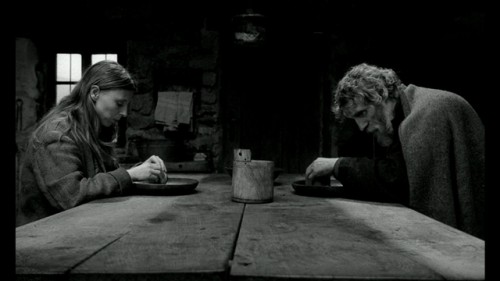
January 15th, 2014 / 10:00 am
FUCK YER BRAND, IMMA DO ME (/help me figure out my brand?)
[u shd probably read the NOTE(S) as they come up for cohesion, but do as u wish, obvi]
so there s a lot of things that have been going on here, on our dearly beloved htmlg. there seems to be an even bigger emphasis than ever before on attn. and i won t lie, it is nice to feel that w/e it is i might have written here might have been read or provoked a thought to someone—ANYONE—outside of me. but the reason i am writing this, right now is to set up a personal statement of sorts for how i want to use this site, as someone who regularly (?) tries to put stuff up…
MISSION STATEMENT(S)
I will refuse to care about being “cool.” I reject the notion of a grotesquely narcissistic coolness in an alt lit universe, where we are all nerds, when viewed through the larger lens of people who are not only unaware of this lit stuff, but also actively ignore its existence.
Perhaps I am just the biggest loser in the universe, but I like to care. If I did not, maybe I would not want to write. The reason I started writing was to figure out things I was genuinely curious about, not always in a healthy fashion. It was not to one-up anyone, not to be smarter in a gimmicky sort of way that will fade and might feel cheap in a couple of years.
HTMLG was one of the places online I constantly returned to when I was in a cubicle day after day doing shit I hated, trying to find a way out. To me, it used to be a liberating space, a meaningful forum that introduced me to writing I care for, and still value. Now, it is confusing. I have the hardest time figuring out the intentions behind what is being written. Sometimes I wonder if pressing “publish” was the entire goal of some contributor; I do not think it should be. [1]
An amazing book of poetry was loaned to me, to remind me of my incentives and goals. Ann Lauterbach is brilliant, even though she cares. Or maybe because of it. I do not write poems, but her intentions—as presented in the middle section of “Under The Sign” are ones I would like to have as ideals.
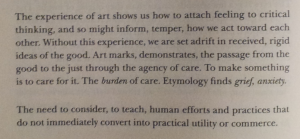
So perhaps caring is not so bad. I will not actively try to not care about writing; writing by those who don’t care does not interest me.
But to care, one needs to put something at risk. One must “open,” perhaps even lose a part of their “security”—usually stemming from exercising a controlled performance of confidence—by showing insecurity. Being clevererererer just shouldn’t cut it if one wants to be true to oneself. [2]
I like the way Lauterbach understands writing. I wish we all agreed on that a little more, but I won’t force it upon you, because that would go against my principles.
NOTE(S)
[1] It is entirely possible that the reason I feel this way about putting words together in a creative way is because I did not study it. Maybe the excessive studying of something leads some of my fellow HTMLG contributors to an insipid cynicism that is often reduced to “being smarter.” Maybe it has to do with the frustrations of a young writer—or new, actually— as an immaterial existence in a material universe: the rewards of writing are rarely fiscal.
The fixation on rapid success that is intrinsic in late-capitalism has infected our immaterial universe, stigmatizing creative intentions. And I am aware money is—and probably will be—an issue for a lot of us/ you/ whatever you want me to say. But to let it dictate creative intentions would be embracing defeat.
2013 Holiday Shopping Guide: Nonfiction Recommendations

I did this last year and some folks seemed to dig it; plus, I enjoy the hell out of making lists and reading lists like these so I’m doing it again this year.
Even granting that these represent my own interests (film, philosophy, art, literature, etc.) and therefore omit plenty of titles I’m sure were great but fall outside my purview, with so many badass nonfiction books published this year it was nearly impossible to select only twenty titles. Tough cuts had to be made.
So my thinking behind this list was to present you with books that might not already be on your radar. Which is to say, a brilliant book such as Scott McClanahan’s Crapalachia: A Biography of Place, or Rebecca Solnit’s The Faraway Nearby
, or Jamie Iredell’s I Was a Fat Drunk Catholic School Insomniac
, for instance, aren’t on this list because I figure you’ve already read them or are at least aware that they are completely awesome and that you need them.
Without further blah blah, you can expect two more of these in the coming days, one for fiction and one for poetry.
If you’re like me and haven’t even begun shopping yet, hopefully this list will help you find something for someone. Oh and for those who care, my click-throughs use my Amazon Affiliate number…the pennies that come back to me when you click on the titles go toward diapers and baby soap for my four month old son.
Interview with Christine Lee Zilka and Jennifer Derilo of the Kartika Review
I’ve always been curious about the darkroom where literary magazines come together. This is a series of interviews engaging, talking, and sometimes annoying editors about their magazines. How did they come about, what do they hate about editing, and what do they love most about it?
This is the third in the series and I talked with Fiction Editor, Christine Lee Zilka, and Creative Nonfiction editor, Jennifer Derilo. Their about page has the following description: “Kartika Review is a national literary arts magazine that publishes Asian Pacific Islander American fiction, poetry, creative non-fiction, and art. Kartika Review serves the Asian Pacific Islander American (APIA) community and those involved with Diasporic Asian and Pacific Islander-inspired literature. We scout for compelling APIA creative writing and artwork to present to the public at large. Our editors actively solicit contributions from established virtuosos in our community in hopes their works here will inspire the next generation of virtuosos. Kartika also promotes emerging writers and artists we foresee to be the future powerhouses of their craft. Ultimately, Kartika strives to create a literary forum that caters to and celebrates the wordsmiths of the Asian Diaspora.”
What’s always drawn me to the review is their focus on great stories. The APIA experience is incredibly diverse and the Kartika Review pushes the boundaries of what constitutes APIA literature. The settings may differ and so may some of the sentiments of the narrators, but at the core, the emotional resonance transcends any differences. The tales, poetry, essays, and imagery form a unique flotilla of art that is as portable as it is relatable. I hopped on board with the two editors and what followed was an organic and fun trek through the editorial rivers of the review.
***
As a brief bio and introduction to Christine (CLZ) and Jennifer (JD):

Christine Lee Zilka is the Fiction Editor at KARTIKA REVIEW. Her work has appeared in journals and anthologies such as ZYZZYVA, GUERNICA, VERBSAP, HYPHEN, and MEN UNDRESSED. She has a novel in progress.

Jennifer Derilo is the Creative Nonfiction editor at Kartika Review. She has a memoir in progress. She often has nightmares about zombies. And abandoned predicate parts.
***
PTL: When and how did you first get involved with Kartika Review?
CLZ: I subbed a short story for consideration to Kartika in early 2008–and I got an email from Sunny Woan, our Founding Editor, saying she loved the piece and wanted to know if I would be interested in becoming Kartika’s Fiction Editor (the previous Fiction Editors departed after Kartika’s second issue). I told her yes! It was my call whether or not to have the piece published; I’m not a big proponent of editors publishing their own work at the litmag for which they work, so I withdrew the piece. The rest is history. I found a passion project in Kartika Review and a fantastic friend in Sunny. And recently, that story just got accepted for publication in another litmag. I owe a lot to that story.
JD: Christine and I were in the MFA program at Mills, but she was in the cohort ahead of me. I first met her when she was the TA for a teaching pedagogy class during my first semester in 2006. While she was an excellent TA, she also coaxed me out of my shell. I started to see her as a big sister type who had the best advice about classes, professors, the program itself, and eventually writing. We kept in touch after we both graduated (I kept going to her for advice!), and then sometime in 2008, Christine asked me to submit something to KR, but in true Jenn Derilo fashion, I never did. And then in 2009, she asked me to join because the CNF editor before me was moving onto other things. I’m sorry for all that backstory about my friendship with Christine, but if I didn’t initially glom onto her (ok…that’s not supposed to sound as creepy, stalker-ish, aggressive as it might), I don’t know that I would ever have been exposed to KR. I was such a writing/literary n00b when I started Mills, and I certainly knew nothing about APIA literature. But she talked about Kartika with such passion, and I was so impressed with the work they were doing, I couldn’t not join. I was supremely honored.
CZ: Jenn is modest. She’s an awesome writer. And has done amazing things as an editor at Kartika.
JD: Aw, shucks. Thank you. I’m lucky to be on an editorial board with multi-talented women of color. And I can’t stress that enough: women of color.
PTL: Christine, I really liked it when you said in regards to your editorial selections: “I often pick pieces by Asian Americans that aren’t API-centric. There are no rules, and Naomi Williams breaks them with brilliance.” What are some works that you both think exemplify Asian Pacific Islander American (APIA) literature, and how did those works affect and influence you?
CLZ: Twenty years ago, this question would have had a more clear cut answer. I would probably have said Maxine Hong Kingston’s WOMAN WARRIOR or Chang-rae Lee’s NATIVE SPEAKER. To that end, I’m motivated both as a writer and as an editor to broaden APIA literature. I’m happy to say there’s no single work that stands out to me, anymore. And I’m also happy that I’m a gatekeeper who gets to have a hand in diversifying the pool. I’m in front of a verrrry small gate, but it’s a gate, nonetheless.
JD: While I know this question is directed at Christine, I can’t help jumping in and agreeing with her, especially given that my knowledge of APIA literature was limited before joining KR. I even knew little about the APIA cannon. But what we do at KR is different. I do feel like we’re “diversifying the pool”, such as including the work of emerging writers alongside interviews with household names. We aren’t only publishing APIA writers who engage with APIA themes. I think Christine nails it when she says, “I’m happy to say that there’s no single work that stands out to me, anymore.” I mean, wow. What a brave discovery to voice! This is not to say that no submissions stand out because, clearly, we publish those pieces shake us. What’s important about that statement is that no one work encapsulates, defines, pigeonholes APIA literature. Rather each work broadens this scope.
PTL: I love the definition of “Kartika” as mentioned on the site: “In Vajrayana (or Tibetan) Buddhist tradition, the kartika, a crescent-shaped knife, symbolizes the cutting away of ignorance and superficiality, with the hopes that it will lead to enlightenment.” What are some themes and elements you both look for in the selections you make for short stories and non-fiction essays?
JD: I don’t know if this is cliche, but I’m attracted to creative nonfiction that surprises me. Even if submissions are about common themes, if the approach to language, structure, or voice is undeniably fresh or risky, I quickly gravitate toward them. It’s difficult to pinpoint exactly what floors me. The best way to understand my madness is to read our back issues starting with #6, which is, of course, when I joined.
CLZ: When I’m looking through the slushpile, pieces tend to blur into each other—so I too, am looking for something different. I’m looking for stories that hit something out of the ballpark, be it concept, structure, language, or ultimately, story. What haven’t I seen before?
How I wrote my latest novel, part 1
I’ve wanted for a while now to try writing a story “live” here, posting my work as I went from initial idea to finished piece. I might still do that, but for now, here’s a related series of posts. I spent the past forty days writing a new novel (“Lisa & Charlie & Mark & Suzi & Monica & Tyrell,” though my working title was “The Porn Novel”), and want to share with you how I did that. My hope is this will prove less an exercise in vanity and more something instructive—like, you might want to do the exact opposite of me.
Let me state up front that I don’t think there’s any one way to write novels, or fiction, and I don’t approach all of my projects in the same way. And what works for me may not work for you. But I have developed some basic procedures that I find useful and that you might enjoy trying. Also, this time around, I encountered some formal problems that should make for good discussion.
I write pretty quickly, but forty days is the fastest I’ve written a novel. (This is the third one I’ve really completed.) My first novel, Giant Slugs, took nearly a decade from start to finish, during which time I wrote three completely different versions of the book. That experience was, on the whole, difficult and often mystifying. Only in the final two years, when I wrote the final version of the novel, did I feel as though I understood what I was doing, and even then I felt crazily out of control most of the time. I had by then a Master’s in Creative Writing, but never received much instruction in novels, so I had to figure out a great deal on my own. (Perhaps that’s inevitable?)
I wrote my second novel, “The New Boyfriend” (still unpublished) as an anti-Giant Slugs: whereas GS is a mock-epic with dozens of characters and locations, covering several years, “TNBF” is a single scene featuring four characters, set in a single location on a Sunday afternoon/evening. That project took me seventy-five days total, which taught me that time is a resource, and some projects take less of it than others. I’m sure I’ll return to more time-intensive projects later, but for now, I’m having fun sprinting.
Recently I’ve wanted to try writing a novel in one month, and when I dreamed up this new project, it seemed a good candidate for that. (And, no, I’ve never done NaNoWriMo, though I have done the 3-Day Novel Contest about six times. I learned a lot from doing the 3-Day, but never produced what I’d consider a finished novel.)
SOME BOOKS THAT I’VE RECENTLY ACQUIRED THAT I ‘M REALLY EXCITED ABOUT.
***
The Spectral Lens & Apparition of a distance, however near it may be by Paul Soulellis
I met & discovered the work of Paul Soulellis at the recent LA Art Book Fair and got super excited right away.

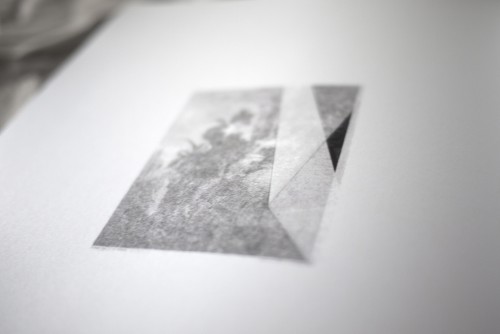
As taken from his website (as are the photos above):
The Spectral Lens (Twenty-Six Stories from the Book Machine) (2012) is a visual poem featuring images photographed by Google book scanners through tissue paper. The scanner treats the tissue paper as a “valid” page in the book and scans it as it would any page, capturing the image (or text) behind it. The images are degraded in various ways, depending on the texture and opacity of the vellum. Rips or folds in the tissue are sometimes captured.
The images are “mistakes”—visual information that might normally be corrected or removed by bots. Instead, the errors remain as permanent additions to the Google Books library, forever altering the viewer’s perception of the work.
I search for these mistakes and treat them as found photography. My screencaptures expose deviations in the algorithms hiding deep within the archive.
The Spectral Lens is at once the glass eye of the book machine and its faceless human operator; it is also the lens-less “camera” of my computer.
I was immediately struck by the haunting simplicity of these images, that such a strange and technological process could aid in creating such immediate & subtle emotional works.
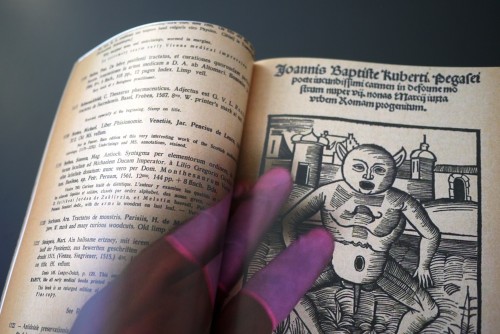
His other project, though similar in technological source looks at a different sort of glitch. Also from his website:
Apparition of a distance, however near it may be (2013) is a collection of found images portraying Google Books employees physically interacting with books inside the digital space of the book scanner, gathered into a 42-page print-on-demand publication.
As accidental recordings, the images mistakenly add human physicality, movement and distortion to the experience of consuming the static book in a browser window. These anomalies are usually corrected or removed by bots, but sometimes the errors remain, becoming spectral additions to the Google Books library and permanently altering the viewer’s perception of the content.
Here the images aren’t haunting, but slightly unsettling and creepy. Something about the lingering, partially-gloved hand that adds a strange layer to the usually austere realm of Google Books.
April 26th, 2013 / 2:46 pm
THE PULPIT vs. THE HOLE by JAY SHEARER
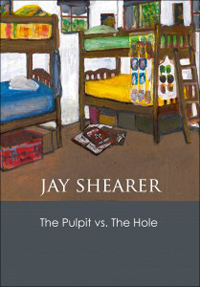 The Pulpit vs. The Hole
The Pulpit vs. The Hole
by Jay Shearer
Gold Line Press (Winner of 2011 Fiction Chapbook Competition)
54 pages / $10 Buy from Amazon or Gold Line Press
If you like underlining pleasurable and provocative sentences with a pencil, plan on keeping a sharpener at the ready while reading Jay Shearer’s chapbook The Pulpit vs. The Hole. Gold Line Press understandably selected this story as the winner of their 2011 Chapbook Competition. This smallish booklet held me steadfast. The setting of a Brethren/Mennonite summer camp for adolescents is teeming ground for a fairly high order of microcosmic examination. Poetry pervades the prose and makes the prospect of underlining daunting, distracting and mildly disorienting. Also, I’m a sucker for parenthetical phrases set off with em dashes. By page two I became mopey about the brevity of the book. My desire thumming, I wondered, how can this book possibly give me all I need in such an austere package? Should I even get attached to these characters since our time together is destined to be short? What’s with these chapbooks anyway? Chapbooks are so concentrated that they make everything else seem like watery Kool-Aid. You will need to put down the pencil.
Shearer imbued The Pulpit vs. The Hole with a scattering of themes that scoot and zip around the book like pre-adolescents hotfooting it through the woods at Camp Abednego. Pacifism is a hard sell to the youth of this book. Shearer deals with pacifism through the precocious voice of his youthful narrator, Marty. The slow to grow understanding of the pitfalls of non-participation reminded me of what had seemed a deeply significant process. Marty and Jordan, another camper, struggle to understand the limitations and challenge the boundaries of the adults’ proclaimed pacifism. They seem to be pushing into view some form of active pacifism.
In dealing with pacifism, certain questions arise. The question of all questions, the question meant to discredit pacifism, the question that— asked or unasked— remains central to the demoralization and hindrance of complete alignment with the older forms of un-programmed Quakerism, the Brethren-ism, or the Mennonite-ism. We know the discomfort of the camp counselor as he listens to the disquieting question: “ ‘what would you do in World War Two?’ ” (p. 20). Of course the invocation of such a fundamental injustice comes from the endearingly irascible camper Jordan. Young people live in a constant state of hyperbole, and to invoke World War II is to force the adults to realize that this state of hyperbole, has at times, been a reality. So what, would you like “ ‘just let the Nazis kill all the Jews?’ ” (p. 20). Counselor Dan, answering for the entire population of pacifists — dare he say it? The answer he has to give? The answer that must, but can’t come with conviction, that “ ‘first, as with anyone, we’d try to talk to them’ ” (p. 21). Jordan scoffs quintessentially American indignation at this passive response offered up with only lukewarm sentiment on the floor of a camp cabin.
February 27th, 2013 / 12:00 pm

